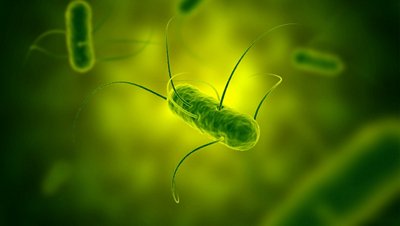Salmonella Enteritidis and Typhimurium
Two Major Serotypes Responsible for Human Infections
November 24, 2021

WHAT ARE THE ENTERITIDIS AND TYPHIMURIUM SALMONELLA SEROTYPES?
Salmonella enterica is a leading worldwide cause of foodborne human illnesses (WHO, 2015).
Salmonella isolates can be differentiated into serotypes according to the Kauffmann-White classification based on their flagellar (H) and somatic antigens (Grimont P. & Weill F.X., 2007) or using genome-based serotyping approaches (Banerji S. et al., 2020).
Among the > 2500 referenced serotypes (Ibrahim GM and Morin PM, 2018), Enteritidis and Typhimurium have proven to be both consistent contaminants along the food chain but more importantly as prominent isolates from diseases in humans (EFSA & ECDC, 2021).
These two serotypes are indeed particularly adapted to hostile environments such as farm animals or food industries’ environments and ultimately, human bodies. Their chromosomal or plasmid-borne virulence and regulatory factors often associated to antimicrobial resistance determinants (Cadel-six S. et al., 2021) confer upon them striking fitness for survival and spread (Chen R.A. et al., 2019; Huang X. et al., 2019; Guillén, S. et al., 2021).
WHAT ARE THE RISKS FOR THE CONSUMERS?
Salmonella Enteritidis and Typhimurium are in the worldwide top 5 serotypes responsible for human infections (EFSA & ECDC, 2021; CDC, 2020). They can cause serious and sometimes fatal infections in young children or elderly people, and others with weakened immune systems. Healthy persons infected with Salmonella often experience fever, diarrhea (which may be bloody), nausea, vomiting, and abdominal pain. In rare circumstances, infection can result in the organism getting into the bloodstream and producing more severe illnesses. Mortality is generally less than 1%; However, S. Enteritidis has a 3.6% mortality rate in outbreaks with the elderly being particularly affected. (FDA, 2012).
Key figures:
In the EU, salmonellosis is the second most reported gastrointestinal infection in humans and an important cause of food-borne outbreaks. In 2019, salmonellosis in humans had a notification rate of 20.0 cases per 100,000 population, which was at the same level as in 2018. The trend for salmonellosis in humans has been stable over the last 5 years (EFSA/ECDC, 2021). As in previous years, the three most reported Salmonella serotypes in 2019 were S. Enteritidis (50.3%), S. Typhimurium (11.9%) and monophasic S. Typhimurium (1,4,[5],12 : i : - ) (8.2%), representing 70.3% of the 79,300 confirmed human cases with known serovar in 2019.
In the US, Enteritidis and Typhimurium were in the top 6 most reported serotypes in 2019. Enteritidis has been the most common cause of Salmonella infections since 2007 and incidence (2.6 per 100 000) has not decreased. Typhimurium moved from the most common serotype during 1996–1998 to the third most com¬mon in 2019. Compared with 2016–2018, incidences was significantly lower in for Typhimurium (1.3 per 100 000 population; - 13%) and 1,4,[5],12: i :- (0.7 per 100 000; -28% ) (CDC, 2020).
HOW ARE ENTERITIDIS & TYPHIMURIUM TRANSMITTED?
Salmonella is widely dispersed in nature. It can colonize the intestinal tracts of vertebrates, including livestock, wildlife, domestic pets, and humans, and may also survive for a long time in the environment. It is spread through the fecal-oral route and through contact with contaminated water. It may, for example, contaminate meat, irrigation water (thus contaminating produce in the field), soil and insects, factory equipment, hands, kitchen surfaces and utensils (FDA, 2012).
Salmonellosis is mostly foodborne (94 % - Scallan E. et al., 2011) but direct contact with live animals and environmental transmission have been identified as potential sources (Pires S.M. et al., 2011).
More specifically, Salmonella Enteritidis has been closely associated with laying hens (Pires S.M. et al., 2011). It can notably be vertically transmitted from an infected hen to the egg white prior to shell formation (FDA, 2012). International trade of infected poultry breeding stocks could moreover contribute to the global spread of this serotype (Li S. et al., 2021). On another hand, Typhimurium has been mainly associated with the pig reservoir (Pires S.M. et al., 2011; Munk et al., 2020; Arnold et al., 2021).
WHAT ARE THE FOOD INDUSTRIES AFFECTED BY ENTERITIDIS & TYPHIMURIUM?
Enteritidis and Typhimurium are associated with the most important food-producing animals and the corresponding food sectors (WHO, 2002; WHO, 2016).
In the EU in 2019 (EFSA & ECDC, 2021), Enteritidis was primarily linked to broiler sources (broiler flocks and meat) (67.8%) and with layers (laying hens flocks and eggs) (26.7%); Enteritidis accounted for 50% of all Salmonella isolates serotyped from eggs and for 25.2% of isolates from broiler meat.
Typhimurium was mainly associated with fattening pigs and meat (42%), broiler (34.8%) and layers (13.5%). Monophasic S. Typhimurium were associated with pig (72.1%) and broiler (17.1%) sources. Typhimurium accounted for 12.7% and 14% of the serotyped isolates from pig herds and pig meat and its monophasic variants accounting for 28.8% and 26.6% of serotyped isolates from these matrices, respectively. For bovine meat, 31.8% and 13.6% of serotyped isolates were S. Typhimurium and its monophasic variants, respectively.
HOW CAN SE & ST BE PREVENTED AND CONTROLLED IN THE FOOD INDUSTRY?
Mandatory prevention of adulteration of foodstuffs by pathogenic microorganisms such as Salmonella spp. (EU 178/2002; Federal Food, Drug & Cosmetic Act, 1938; FDA-FSMA, 2011) has led to the regulatory-driven implementation of HACCP- based control systems and Good Hygiene (GHP)/Manufacturing practices (FDA 21CFR 1 et al., 2015; 9CFR304 et al., 1996; EU 852/2004).
Moreover, considering the great public-health significance of the Enteritidis and Typhimurium serotypes, additional regulatory control measures have been introduced in the EU i) through the Zoonoses Package to reduce the prevalence of Salmonella Enteritidis and Typhimurium - positive poultry flocks (EU 2160/2003 and amendments) and ii) in the Hygiene Package (EU 1086/2011 amending the EU 2073/2005 food hygiene criteria regulation) to prohibit the presence of Enteritidis and Typhimurium in fresh poultry meat.
In the US, the FDA set up both specific regulation (21CFR Parts 16 and 118) and guidance (FDA, 2015) for the prevention of Salmonella Enteritidis in Shell Eggs During Production, Storage, and Transportation. In addition, the USDA – APHIS (Animal & Plant Health Inspection Service), in cooperation with Industry members and States, defined S. Enteritidis - specific technical and management provisions in the National Poultry Improvement Plan (9CFR Parts 146, 146, 147).
HOW CAN THE PRESENCE OF ENTERITIDIS & TYPHIMURIUM BE DETECTED IN THE FOOD INDUSTRY?
EU and US regulations specifically require that food business operators perform microbiological testing as appropriate when they are validating and verifying the effectiveness of their HACCP and GHP -based control systems (EU 852/2004; FDA, 2011).
Regular Salmonella spp., S. Enteritidis and S. Typhimurium monitoring is additionally put in place i) by regulatory agencies for compliance and surveillance purposes (EU 625/2017; FDA, 2011) and ii) within concerned food sectors by business partners, primarily for customer protection but also for the prevention of both mandatory product recall (FDA, 2011; EU 178/2002) and legal prosecution.
Different microbiological methods either traditional or molecular (PCR or Whole Genome sequencing) for the detection of Salmonella spp and/or serotyping of Salmonella Enteritidis or Typhimurium have been described, notably:
- Standardized reference methods, . the FDA-BAM, 2021, . the USDA NPIP standard, 2019 . the MLG 4.11, 2021 . the ISO 6579-1:2017 and 2020 amendment, ISO TR 6579-3:2014 (serotyping), ISO/DTS 6579-4 (1,4,[5],12,i:-).
- AOAC or EN ISO 16140-2:2016 or ISO 16140-6:2019 validated alternative methods. Compared to the standard methods, these rapid methods usually bring ease of use to the users as well as reduced times to results which add flexibility to the management of the analytical and business flows.
bioMérieux provides the food safety managers with proven standardized or validated methods for the management of Salmonella spp. or S. Enteritidis & S. Typhimurium along the Food Chain.
BIOMÉRIEUX SOLUTIONS AND PRODUCTS
GENE-UP® Molecular pathogen detection automated platform:
-GENE‑UP® S. Enteritidis & S. Typhimurium kit (SEST) (Ref.423127)
Real‑time Polymerase Chain Reaction (PCR) assay for the detection of Salmonella Enteritidis and Salmonella Typhimurium in food.
(Official validation to come in 2022)
BIOBALL® - Standardized Strains for food applications:
- BIOBALL® A small freeze dried water-soluble Certified Reference Material containing a precise number of viable micro-organisms for your Microbiological Quality Controls
- BIOBALL® LUMINATE 2.0 Green Fluorescent Protein Strains (GFP), Genetically Modified Microorganisms (GMM) to distinguish from natural contaminantsList of official validations (for GENE-UP® methods)
For all other solution dedicated to Salmonella detection, please refer to the Salmonella spp. scientific page
REFERENCES
Arnold M. et al. Bayesian Source attribution of Salmonella Typhimurium isolates from human patients and farm animals in England and Wales. 2021. Front. Microbiol. 12:579888.
Banerji S. et al. Genome-based Salmonella serotyping as the new gold standard. Nature Research, 2020, 10:4333.
Cadel-Six S. et al. The Spatiotemporal Dynamics and Microevolution Events That Favored the Success of the Highly Clonal Multidrug-Resistant Monophasic Salmonella Typhimurium Circulating in Europe. Front. Microbiol. 2021, 12:651124.
CDC (US Center of Disease Control). Preliminary Incidence and Trends of Infections with Pathogens Transmitted Commonly Through Food — Foodborne Diseases Active Surveillance Network, 10 U.S. Sites, 2016–2019. MMWR. Morb. Mortal. Wkly Rep., 2020, 69 (17): 6 p.
Cheng RA. et al. Embracing Diversity: Differences in Virulence Mechanisms, Disease Severity, and Host Adaptations Contribute to the Success of Nontyphoidal Salmonella as a Foodborne Pathogen. Front. Microbiol. 2019, 10:1368.
EFSA and ECDC (European Food Safety Authority and European Centre for Disease Prevention and Control). The European Union One Health 2019 Zoonoses Report. EFSA Journal 2021 ;19(2):6406, 286 p.
EU Regulation 178/2002 laying down the general principles and requirements of food law, establishing the European Food Safety Authority and laying down procedures in matters of food safety: 24 p.
EU Regulation 2160/2003 on the control of Salmonella and other specified food-borne zoonotic agents: 21 p.
EU Regulation 2073/2005 on microbiological criteria for foodstuffs: 26 p.
EU Regulation 852/2004 on the hygiene of foodstuffs: 23 p.
EU Regulation 1086/2011 as regards Salmonella in fresh poultry meat: 5 p.
EU REGULATION 625/2017 on official controls and other official activities performed to ensure the application of food and feed law. 142 p.
FDA (Food and Drug Administration). Bad Bug Book, Foodborne Pathogenic Microorganisms and Natural Toxins - Salmonella species. Second Edition. 2012: 5 p.
FDA. 21 CFR Parts 16 and 118. Prevention of Salmonella Enteritidis in Shell Eggs During Production, Storage, and Transportation; Final Rule. 2009: 73 p.
FDA. Guidance for Industry: Questions and Answers Regarding the Final Rule, Prevention of Salmonella Enteritidis in Shell Eggs During Production, Storage, and Transportation. 2015: 14 p.
Federal Food, Drug & Cosmetic Act. To prohibit the movement in interstate commerce of adulterated and misbranded food, drugs, devices, and cosmetics, and for other purposes. 1938.
FDA Food Safety Modernization Act (FSMA) – Public Law to amend the Federal Food, Drug, and Cosmetic Act with respect to the safety of the food supply. 2011. 89 p.
FDA. 21CFR Parts 1, 11, 16, 106, 110, 114, 117, 120, 123, 129, 179, and 211. Food Safety Modernization Act. Current Good Manufacturing Practice, Hazard Analysis, and Risk-Based Preventive Controls for Human Food. 2015, 80 (180): 55908-56168.
FDA - BAM (Bacteriological Analytical Manual) - Chapter 5: Salmonella. 2021: 24 p.
Grimont P., and Weill F.X. Antigenic Formulae of the Salmonella Serovars. 9th Edn. Paris: WHO Collaborating Centre for Reference and Research on Salmonella. 2007: 167 p.
Guillén, S. et al. Impact of the Resistance Responses to Stress Conditions Encountered in Food and Food Processing Environments on the Virulence and Growth Fitness of Non-Typhoidal Salmonellae. Foods 2021, 10, 617.
Huang X. et al. Transcriptional sequencing uncovers survival mechanisms of Salmonella enterica serovar Enteritidis in antibacterial egg white. mSphere, 2019, 4 (1): 19 p.
Ibrahim GM and Morin PM. Salmonella Serotyping Using Whole Genome Sequencing. Front. Microbiol. 2018, 9:2993.
ISO 6579-1 2017. Microbiology of the food chain — Horizontal method for the detection, enumeration and serotyping of Salmonella — Part 1: Detection of Salmonella spp.
ISO 6579-1:2017/AMD 1:2020 - Microbiology of the food chain — Horizontal method for the detection, enumeration and serotyping of Salmonella — Part 1: Detection of Salmonella spp. — Amendment 1: Broader range of incubation temperatures, amendment to the status of Annex D, and correction of the composition of MSRV and SC.
ISO/TR 6579-3:2014. Technical report - Guidance for serotyping of Salmonella spp.
ISO/DTS 6579-4 (expected to be published in 2023) Microbiology of the food chain - Horizontal method for the detection, enumeration and serotyping of Salmonella - Part 4: Identification of monophasic Salmonella Typhimurium (1,4,[5],12,i:-) by polymerase chain reaction (PCR).
ISO 16140-2:2016 - Microbiology of the food chain - Method validation - Part 2: Protocol for the validation of alternative (proprietary) methods against a reference method.
ISO 16140-6:2019 - Microbiology of the food chain - Method validation - Part 6: Protocol for the validation of alternative (proprietary) methods for microbiological confirmation and typing procedures.
Li S. et al. Global spread of Salmonella Enteritidis via centralized sourcing and international trade of poultry breeding stocks. Nature Communications. 2021: 12 p.
Munck N. et al. Application of Whole-Genome Sequences and Machine Learning in Source Attribution of Salmonella Typhimurium. Risk Analysis, Vol. 40, No. 9, 2020: 1693-1705.
Pires, S. M., et al. Technical report submitted to EFSA. Estimation of the relative contribution of different food and animal sources to human Salmonella infections in the European Union. National Food Institute, Technical University of Denmark. EFSA J., 8 (8), 2011: 80 p.
Scallan E., et al. Foodborne illness acquired in the United State, major pathogens. Emerging Infectious Diseases, 2011; 17:7–15.
USDA (US Department of Agriculture) – APHIS (Animal & Plant Health Inspection Service) –
. 9CFR 145 National Poultry Improvement Plan (NPIP) for breeding poultry.
. 9CFR 146 – NPIP for commercial poultry.
. 9CFR 147 – Auxiliary provisions on NPIP.
USDA-FSIS 9CFR Parts 304, 308, 310, 320, 327, 381, 416, and 417. Pathogen Reduction; Hazard Analysis and Critical Control Point (HACCP) Systems; Final Rule.1996. 185p.
USDA - National Poultry Improvement Plan Program Standards. 2019: 64 p.
USDA – FSIS. MLG 4.11. Isolation and Identification of Salmonella from Meat, Poultry, Pasteurized Egg, and Siluriformes (Fish) Products and Carcass and Environmental Sponges. 2021: 19 p.
WHO (World Health Organization) and FAO (Food and Agriculture Organization). Risk assessments of Salmonella in eggs and broiler chickens. Microbiological Risk assessment series. 2002: 329 p.
WHO. WHO estimates of the global burden of foodborne diseases. Epidemiology reference group 2007-2015, 2015: 265 p.
WHO and FAO. Interventions for the control of Non-typhoidal Salmonella spp. in beef and pork. Microbiological Risk assessment series. 2016: 295p.
ON THE SAME SUBJECT






